Abstract
Blending of different ore types in the concentrator feed contributes significantly to maintaining a high recovery of valuable minerals with required grades in the concentrate. It is feasible to develop an ore-blending scheme over the life of a mine already in the design phase of the plant. In addition to ore characteristics, water quality is known to impact mineral recovery. A blending plan could also be developed for the different water streams of a future concentrator. This paper describes a novel modeling and simulation approach to predict metallurgical response combining ore types and water quality. The model is based on kinetic laboratory flotation test data, and it was tested on a case study. As a result, rougher flotation grade-recovery curves dependent on ore types and water quality are presented over the predicted life of the mine. The simulation results can be exploited in project design to maximize the recovery of valuable minerals and to ensure environmentally sound and profitable mining operations. Overall, the developed modeling tool can be applied widely for minerals processed by using froth flotation and water types available for kinetic laboratory flotation tests.
1. Introduction
A mining plan has traditionally been developed based only on the head grades of valuable minerals in the ore. In general, a higher ore head grade typically results in a higher grade and recovery at the concentrator. The concept of geometallurgy has been defined around 1970 [1]. The geometallurgical approach that combines geological and metallurgical information has been applied in mine planning and plant design with varying success for some decades [2]. To date, a geometallurgical mining plan is at its best when it incorporates the mine-to-mill concept and the environmental and economic aspects of mining [3]. A holistic view and the utilization of modern process simulation models in planning the mining operations helps to minimize technical and operational risks and control challenges, such as declining ore grades and more complex deposits [4,5].
Studies have shown that along with ore properties, the quality of water also impacts flotation recovery. Water quality commonly deteriorates when water recycling increases in the process, but water recirculation cannot be avoided at concentrator plants for several reasons. First, process water circulation is required due to environmental legislation and the need to receive a social license to operate: a plant’s water system should not cause adverse effects for local communities during or after the mining operations [6]. Second, high cost may limit freshwater intake, as in the cases where water must be pumped to the site through long-distance pipelines in the absence of local water reserves [7]. Even with a positive overall site water balance, due to high rainfall and low evaporation, discharged water from a concentrator to the environment poses a risk and could pollute the aquatic system, which is why the water loop around a concentrator plant should be closed [8]. For these reasons, the quality and quantity of different water streams at a concentrator plant, along with ore variations, must be considered already in the design phase of the project. This contributes to optimized mineral recovery and sustainable operation throughout the life of the mine.
The impact of water properties on flotation performance can be remarkable for some minerals, with one of the most sensitive ones being pentlandite ((Fe,Ni)9S8), the main sulfide nickel mineral [9]. The impurities accumulating in the process may stem from raw water, originate from flotation reagents, or dissolve from the ore to the process water [10]. The extent of the detrimental effects of the impurities depends on temperature, pH, and redox potential in the concentrator process [11]. These process conditions can depend also on seasonal variations, as higher temperature speeds up oxidation reactions [12]. In addition, seasonality significantly affects the composition of river waters, for example, due to chemical denudation of regolith [13]. Examples of impurities inducing adverse effects on flotation include fine serpentine mineral particles that can form a slime coating on the mineral surfaces [14,15,16]. Similarly, thiosulfate (S2O32−) anions, produced when sulfide minerals oxidize [17], compete with collector reagent adsorption on pentlandite [18]. Furthermore, trials with sodium chloride suggest that both cations and anions in the process water can affect pentlandite mineral surface alteration and floatability [19]. In conclusion, as water impurities can make pentlandite particles less hydrophobic and weaken collector reagent adsorption, they may eventually decrease the recovery of pentlandite.
Based on research on water quality impacting flotation, it would be beneficial to consider the blending ratio of different water streams along with the ore types already in the design phase of a mining project. The water sources of a plant are typically known well before the start-up. The composition of internal water streams circulating in and around the concentrator plant, possibly going through water treatment, can be defined during laboratory and pilot tests in the project development phase. Moreover, the kinetics of the ore types, combined with a certain water type, can be calculated using laboratory flotation tests. The recovery of valuable minerals over the life of the mine can be modeled based on the obtained kinetics by employing proven methods and tools, such as the HSC Chemistry® software (version 10.2, Metso, Pori, Finland) [20]. The present study was conducted to improve the geometallurgical mine planning approach by combining the effect of different types of water in the prediction of future concentrator recoveries using an HSC simulation model.
2. Materials and Methods
2.1. Case Study
The case study in this paper, the Anglo American Sakatti Ni-Cu-PGE deposit in northern Finland, is being explored for possible future mining operations. The current estimate of the life of the mine is 240 months. In this study, the preliminary mining plan for the 240 months was simplified so that it consists of three main ore types, massive sulfide (MS), stockwork (STW) and disseminated (DISS). These three ore types, all mined underground, cover, on average, 25%, 40%, and 35% of the plant feed over the life of the mine, respectively. Only bulk rougher flotation was simulated in this study, as typically the rougher recovery in an open-circuit laboratory flotation test is known to accurately predict the overall recovery in an industrial-scale closed flotation circuit. In the planned flowsheet for the future Sakatti concentrator plant, the rougher concentrate is sent for Ni-Cu separation to produce saleable Ni and Cu concentrates. A schematic diagram of the Sakatti flowsheet is presented in Figure 1.
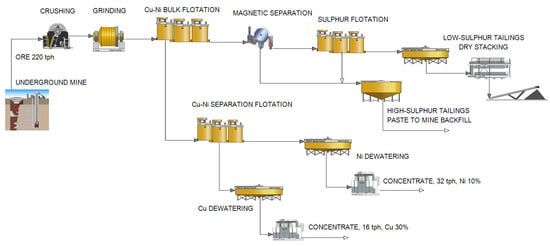
Figure 1.
A schematic flowsheet for Sakatti.
AA Sakatti Mining Ltd. (Sodankylä, Finland) aims to build a sustainable concentrator plant where the degree of recycled process water is maximized and the impact of ore processing on the environment is minimized. Part of the process water is taken from the underground mine where water has a higher level of impurities than fresh surface water. Tailings management includes mine backfill and dry stacking, meaning that most of the process water is circulated within the mineral processing plant and the intake of fresh water from the river Kitinen is limited. Excess recycled and tailings water are sent for water purification before being released to the river Kitinen. Seasonal and process variations affect the water streams in real life so that their composition is not stable. However, this study employed a simplified water scheme consisting of waters from the river, the mine, the tailings facility, the water recycled within the concentrator process, and the blend of these water streams.
2.2. Ore and Water Samples
Representative massive sulfide, stockwork, and disseminated ore samples were received for analyses and test worked at the Metso Research Center in Pori, Finland. The elemental compositions of the samples were analyzed after total dissolution using an inductively coupled plasma optical emission spectrometer (ICP-OES). The mineralogical analyses showed that nickel occurs in both sulfide and silicate minerals in the samples. Therefore, the sulfide nickel and iron contents were determined after bromine–methanol (BM) dissolution [21,22]. The elemental compositions of the Sakatti ore samples are shown in Table 1.

Table 1.
Elemental composition of the Sakatti ore samples used in the flotation tests.
The BM analysis results in Table 1 show that 97% of nickel is carried by sulfide minerals in the Massive Sulfide ore sample and only three percent is present in silicate minerals. However, only 75% of total nickel in the Stockwork ore sample and 50% of all nickel in the disseminated ore is in sulfide minerals, and the rest is carried by silicates. This means that the theoretical maximum recovery that can be achieved by true flotation is lower for the stockwork and disseminated ores compared to the massive sulfide ore.
A mineralogical study was conducted on the samples in addition to the chemical analyses. Polished resin sections of the ore samples were prepared and observed using JEOL JSM-6490LV and 7000F scanning electron microscopes (SEMs) equipped with an Oxford Instruments energy-dispersive spectrometer (EDS). The imaging and EDS analyses applied routine conditions using 20 kV acceleration voltage and 1 nA beam current. Mineral quantification was performed using the HSC Chemistry® software. The minerals present in the samples are listed in Table 2 and shown in Figure 2, Figure 3 and Figure 4.

Table 2.
Mineral composition of the Sakatti ore samples in the tests.
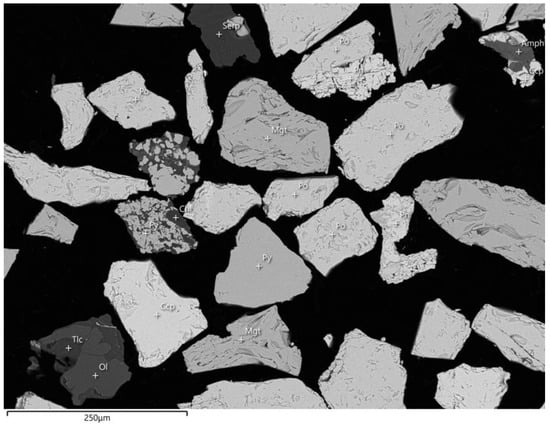
Figure 2.
Massive Sulfide ore sample, > 75 µm fraction. Pentlandite (Pn), pyrrhotite (Po), chalcopyrite (Ccp), pyrite (Py), and magnetite (Mgt) as liberated grains, and pentlandite locked with pyrrhotite. The silicate content (dark particles) is low. The silicate content (dark particles) is low; Talc (Tlc), Olivine (Ol), Serpentine (Serp), and Amphibole (Amph).
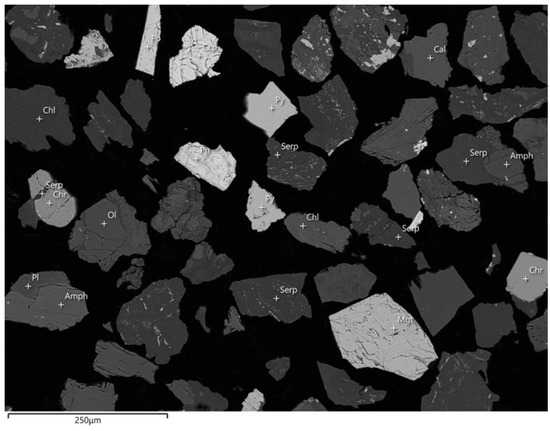
Figure 3.
Stockwork ore sample, > 75 µm fraction. Liberated pentlandite, pyrite, pyrrhotite, chalcopyrite, and magnetite grains adjacent to silicates, including serpentine (Serp), olivine (Ol), chlorite (Chl), amphibole (Amph), and plagioclase (Pl). Chromite grains (Chr) are locked with silicates.
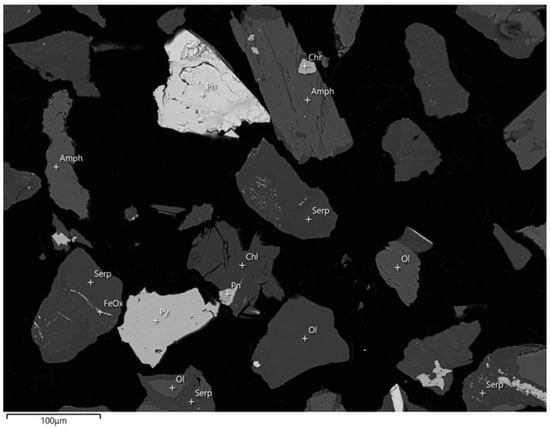
Figure 4.
Disseminated ore sample, >75 µm fraction. Liberated grains of pentlandite and pyrite among serpentine, olivine, chlorite, and amphibole. Pentlandite is locked with chlorite.
Four water samples were used in the laboratory flotation tests (Table 3). AA Sakatti Mining Ltd. provided a sample from the river Kitinen, which would be the source of fresh water for the concentrator plant. The other three water samples were synthetic and prepared by Metso Research Center based on the simulated composition provided by AA Sakatti Mining Ltd. according to the environmental impact assessment report [23]. The synthetic water samples were called mine water, recycled water, and tailings water.

Table 3.
Elemental composition of the water samples in the flotation tests.
2.3. Laboratory Flotation Tests
The Massive Sulfide, Stockwork, and Disseminated ore samples were crushed down to 100% being < 1 mm in particle size. The samples were homogenized and divided into 1.5 kg subsamples. Each flotation feed batch was ground in a laboratory rod mill right before flotation to avoid excess oxidation of mineral surfaces. The target grind size was 80% passing 72 µm. The particle-size distribution after grinding is shown in Table 4 and Figure 5, and the laboratory flotation test flowsheet is shown in Figure 6.

Table 4.
Particle-size distribution of the ground flotation feed.
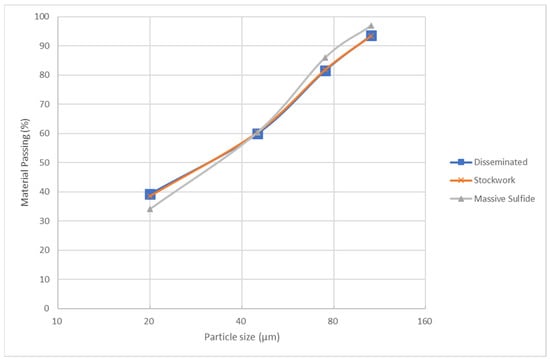
Figure 5.
Particle-size distribution for the ground flotation feed on a logarithmic scale.

Figure 6.
Laboratory flotation test flowsheet. The abbreviations for the test products shown in the flowsheet are RC1–3 for rougher concentrates 1–3 and RT for rougher tailings.
All flotation tests were executed at a temperature of 20 °C. The water type being tested was applied throughout the entire test. Prior to flotation, the test feed batch was ground in a laboratory mill at 60% solids. The grinding time was adjusted for each ore type to reach the target particle size of P80 72 µm. A total of 3000 g/t of Na2CO3 was added to the grinding mill to adjust the pH to the range of 9.5–10.5. The measured pH after grinding depended on the ore type. The collector reagents AERO 3894 (thionocarbamate) and AERO 407 (blend of mercaptobenzodiazole and dithiophosphate) were added to the mill at the dosages of 50 g/t and 50/70 g/t, respectively. The higher dosage of AERO 407 was used for the richer massive sulfide ore. After grinding, the slurry was diluted with the water type to be tested down to 26% solids. Conditioning and flotation were performed using an Outotec GTK LabCell flotation machine in a 4-L cell. The rotor mixing speed was 1800 rpm for conditioning and flotation.
The slurry was first conditioned for 3 min with an additional AERO 407 dosage of 30/70 g/t, with the higher dosage being applied to the massive sulfide ore. Subsequently, 100 g/t of Celect HPD (carboxymethyl cellulose) depressant was added for 2 min of conditioning. An additional 1 min conditioning time was used for the frother, being 40 g/t of MIBC (methylisobutylcabrinol) for the massive sulfide ore, 60 g/t of MIBC for the Disseminated ore, and 40 g/t of Dowfroth 250 (polyglycol ether) for the stockwork ore. It must be noted that any differences in the reagent dosages between the ore types could result in different flotation behavior and, thereby, lead to differences in flotation recovery. However, it was mandatory to adjust the chemical dosages because of the differences in the head grades of the ore types. The reagent dosage levels were selected so that the lack of a collector or a strong enough frother would not hinder the recovery of nickel.
After conditioning, three rougher concentrates were recovered, the first one after 2 min, the second one after 5 min, and the third one after 7 min of flotation. An automatic scraper was used to recover the froth in flotation to avoid human error in testing. During flotation, the air feed rate to the cell was 3 NL/min.
2.4. Simulations
The Sim module of HSC Chemistry® software was adopted to develop a novel kinetic flotation model that includes both ore and water types. The HSC Sim mineral processing models are based on minerals whose recoveries are calculated from the elements analyzed from the flotation test products. In addition, the new models can include multiple incoming water streams that affect the flotation kinetics as per the flotation tests.
Initial mass balancing was achieved for each of the flotation test results in the HSC Mass balance module to reconciliate assay measurements. The reconciliated chemical composition was then converted to mineral grades using HSC Geo modal calculation. A simplified mineralogy was used for the conversion: chalcopyrite (Ccp) represents copper sulfides, pentlandite (Pn) represents nickel sulfides, pyrrhotite (Po) corresponds to the rest of iron sulfides including pyrite, and NSG is the sum of non-sulfide gangue minerals.
Following the reconciliation of the assays and the conversion of minerals, kinetic parameters were fitted to model the laboratory flotation test recoveries using the cumulative retention time (τ) of 2, 5, and 7 min for concentrates RC1, RC2, and RC3, respectively. The rectangular model was used to fit the maximum kinetic rate kmax(l) (min−1) and infinite recovery Rinf(l) (%) with given water type (l) (Equation (1)) (batch rectangular model of the recovery of a given mineral, R(%) at a flotation time τ (min)) for each ore–water combination and mineral. The kinetic parameters for each mineral are given in Table 5. The calculation is as follows:
where n is the value for the discretization of the flotation behaviors of the simulated mineral particles.

Table 5.
Kinetic parameters for the HSC model.
Water types were added as a new feature in the HSC Sim stream setup tool. Water quality was integrated into the calculation of mineral recovery parameters using Equation (2) (simulated recovery calculation based on water ratio):
where .
RSim is the simulated recovery for a given mineral in a given ore type; l (1 to 4) is the index of the water type; Rinf(l) and kmax(l) are the fitted infinite recovery and the maximum kinetic parameter when using water l in the flotation test (Table 5); Ql is the flowrate (m3/h) of water type l to the conditioner; and Qliq the total liquid amount (m3/h) flowing to the conditioner. The parameters Rinf(l) and kmax(l) (Table 5) are given in the conditioner unit model that recalculates Rinf,Sim and kmax,Sim for each mineral in each ore depending on the water ratio. Rinf,Sim and kmax,Sim are then attached to each mineral particle in the stream. The conditioner model is associated with flotation models that generate the separation between floating and non-floating particles according to the selected operation mode and residence time.
The simulations were performed in the batch operation mode, and the fixed flotation times in the flotation cell models were 2, 5, and 7 min for rougher flotations 1, 2, and 3, respectively, similar to the laboratory tests. Froth recovery or entrainment was not implemented in these simulations, and only true flotation (recovery from pulp zone) was considered. The scenario editor feature in HSC Sim was used to produce the nickel grade-recovery curve of the blend of water and ore types for each month over the life of the mine (240 months). In addition, the life of the mine’s ore blends was simulated using only one water type at a time to show the difference in rougher performance depending on the water quality.
3. Results and Discussion
3.1. Simulation Results
To show the effect of ore type on the rougher concentrate grade and recovery, simulations were performed by using only massive sulfide, stockwork, or disseminated ore in the feed with each of the five water types (Figure 7). The massive sulfide ore has a higher head grade, and a clearly higher proportion of nickel occurs in its recovered sulfide minerals than in the disseminated and stockwork ore types.
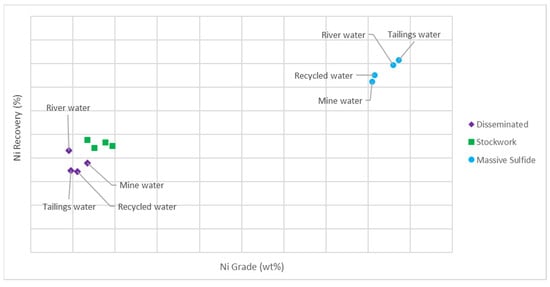
Figure 7.
Simulated total nickel grade and recovery to a rougher concentrate for a single ore type using different water types. Numerical values are not given due to confidentiality reasons.
As expected, the grade and total recovery of nickel in the rougher concentrate are highest with the massive sulfide ore compared to disseminated and stockwork ores. Yet, the flotation performance of the massive sulfide ore depends also on the water type used, as the river and tailings water streams yield the highest recoveries. For the disseminated and stockwork ores with lower head grades, the differences in nickel recoveries between the water types are not that significant, except that using river water provides clearly higher recovery than recycled water. As shown in Table 3, Cl− and Mg levels are especially significantly higher in recycled and mine waters compared to river and tailings waters. Furthermore, recycled and mine waters have higher conductivity than river and tailings waters, indicating that these water streams contain a higher level of impurities in general. The simulated results are in line with previous flotation tests, in which higher nickel recoveries were achieved with lower impurity levels in water [9].
Figure 8 illustrates the simulated rougher flotation’s total nickel grades and recoveries with different water streams as per the preliminary mining plan. The water blend corresponds to the planned mixture of the water streams at the concentrator plant, which is commissioned with only river water and is eventually run with a blend consisting of all four water types. Each point on the graph for each of the five simulated scenarios with different water types represents the ore and water blend predicted for one month during the life of the mine.
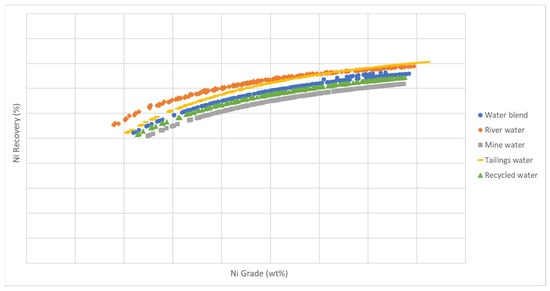
Figure 8.
Simulated total nickel grade and recovery to a rougher concentrate with the ore blend as per the mine plan using different water types. Neither the numerical values for the blending ratios of each ore type nor the simulated grades and recoveries are given due to confidentiality reasons.
Figure 8 shows that water quality significantly affects the rougher flotation performance. The use of river and tailings waters with fewer impurities and lower conductivity leads to higher nickel recoveries compared to the simulated recoveries with more contaminated recycled and mine waters. In contrast, the use of the water blend appears to result in moderate recoveries. The simulation results suggest that to maximize the recovery of sulfide nickel in rougher flotation, water with less impurities should be used.
3.2. Discussion
The presented simulation results should be validated by running laboratory flotation tests on single points from the monthly plan and checking if the rougher recoveries are consistent with the simulated ones. A validation test with a combination of different ore and water types, like in the simulation, would reveal the potential synergy effects in the flotation performance that the current simulation results do not show. For example, Moraga et al. have concluded that the flotation process is sensitive to the dynamic changes at a plant, which can originate, among other parameters, from ore blending [24]. Adding to that, positive or negative synergies may be seen due to the blending of water types. It is possible to further develop the proposed model based on the findings of validation tests.
The consideration of water as a perfect blend in the simulation, as proposed in Equation 2, has its limitations, notably when the compositions of the water streams used vary. The he kinetic flotation parameters can be defined based on the absolute concentration of ions, total dissolved solids, pH, and Eh of the resulting water blend. In this case, multiparameter regression is applied to find the fitted coefficients of the equation, linking the kinetic parameters (i.e., Rmax and kinf) to the water quality parameters per mineral and per ore in the laboratory test results, as suggested in Equation (3) (predictive formula to calculate RSim as a function of the water blend quality parameters).
where na is the number of water quality parameters, and xi is their value (in mg/L or mmol/L for concentration) in the resulting blend. a0 to ana are the fitted coefficients based on lab results. The coupling of machine learning-based models with an HSC Sim-based physical flotation model could be a viable approach to consider the complexity of water composition variations. However, additional factorial testing would need to be performed with actual water blends to better predict kinetic parameter response. In this instance, any kind of water blends, even with intrinsic variation in their quality, could be used for predictive simulation of the flotation process.
4. Conclusions
The main objective of this study was to develop a novel simulation model that can predict flotation recovery over the life of a mine that is affected by variations in both ore types and water quality. The simulation results based on kinetic laboratory flotation tests on the Sakatti ore samples show that a high ore head grade is important for achieving high recovery, but, simultaneously, water quality can significantly impact nickel recovery. Based on the results, it can be concluded that it is crucial to consider the effect of water in addition to ore composition in a plant design, especially in the flotation of pentlandite that is known to be sensitive to water impurities. The developed model will be validated after the start-up of the concentrator when receiving results from the operating circuit.
The developed simulation method is not limited to a certain time range or frequency, amount of ore types, or water streams. The model can also be applied to minerals other than pentlandite as a tool to evaluate future concentrator performance. It is also possible to evaluate future recoveries with simplified ore and water blends and increase the amount of data in the model over time.
Author Contributions
Conceptualization, A.A.; data curation, A.A.; formal analysis, A.A.; funding acquisition, E.S.; investigation, M.L. and A.L.; methodology, A.A. and C.I.; project administration, A.A.; resources, A.A.; software, C.I.; supervision, O.D.; visualization, A.A. and A.L.; writing—original draft preparation, A.A.; writing—review and editing, A.A. and E.S. All authors have read and agreed to the published version of the manuscript.
Funding
This research was funded by Business Finland, 992/31/2020.
Data Availability Statement
The data presented in this study are available on request from the corresponding author. The data are not publicly available due to privacy.
Acknowledgments
The authors acknowledge AA Sakatti Mining Ltd. for providing the ore and water samples for the study.
Conflicts of Interest
The authors declare no conflict of interest.
References
- Mu, Y.; Salas, J.C. Data-Driven Synthesis of a Geometallurgical Model for a Copper Deposit. Processes 2023, 11, 1775. [Google Scholar] [CrossRef]
- Williams, S.R. A historical perspective of the application and success of geometallurgical methodologies. In Proceedings of the Second AusIMM International Geometallurgy Conference, Brisbane, QLD, Australia, 30 September–2 October 2013; The Australasian Institute of Mining and Metallurgy: Melbourne, Australia, 2013; pp. 37–47. [Google Scholar]
- Lishchuk, V.; Koch, P.H.; Ghorbani, Y.; Butcher, A.R. Towards integrated geometallurgical approach: Critical review of current practices and future trends. Miner. Eng. 2020, 145, 106072. [Google Scholar] [CrossRef]
- Dominy, S.C.; O’Connor, L. Geometallurgy–Beyond Conception. In Proceedings of the Third AusIMM International Geometallurgy Conference, Perth, Australia, 15–16 June 2016; pp. 3–12. [Google Scholar]
- Käyhkö, T.; Sinche-Gonzalez, M.; Khizanishvili, S.; Liipo, J. Validation of predictive flotation models in blended ores for concentrator process design. Miner. Eng. 2022, 185, 107685. [Google Scholar] [CrossRef]
- Kinnunen, P.; Obenaus-Emler, R.; Raatikainen, J.; Guignot, S.; Guimera, J.; Ciroth, A.; Heiskanen, K. Review of closed water loops with ore sorting and tailings valorisation for a more sustainable mining industry. J. Clean. Prod. 2021, 278, 123237. [Google Scholar] [CrossRef]
- Ihle, C.F.; Kracht, W. The relevance of water recirculation in large scale mineral processing plants with a remote water supply. J. Clean. Prod. 2018, 177, 34–51. [Google Scholar] [CrossRef]
- Northey, S.A.; Mudd, G.M.; Saarivuori, E.; Wessman-Jääskeläinen, H.; Haque, N. Water footprinting and mining: Where are the limitations and opportunities? J. Clean. Prod. 2016, 135, 1098–1116. [Google Scholar] [CrossRef]
- Aaltonen, A.; Le, T.M.K.; Saari, E.; Dahl, O.; Musuku, B.; Lang, A.; Hiidenheimo, S.; Dixon, R. Improving Nickel Recovery in Froth Flotation by Purifying Concentrators Process Water Using Dissolved Air Flotation. Minerals 2023, 13, 319. [Google Scholar] [CrossRef]
- Liu, W.; Moran, C.J.; Vink, S. A review of the effect of water quality on flotation. Miner. Eng. 2013, 53, 91–100. [Google Scholar] [CrossRef]
- Levay, G.; Smart, R.S.C.; Skinner, W.M. The impact of water quality on flotation performance. J. S. Afr. Inst. Min. Metall. 2001, 101, 69–75. [Google Scholar]
- Musuku, B.; Kasymova, D.; Saari, E.; Dahl, O. Influence of Water Quality on Sulphide Ore Oxidation and Speciation of Sulphur Anions during Autogenous Milling. Minerals 2023, 13, 277. [Google Scholar] [CrossRef]
- Beylich, A.A.; Schmidt, K.H.; Neuvonen, S.; Forbrich, I.; Schildt, A. Solute fluxes in the Kidisjoki catchment, subarctic Finnish Lapland. Géomorphologie Relief Process. Environ. 2006, 12, 3. [Google Scholar] [CrossRef]
- Edwards, C.R.; Kipkie, W.B.; Agar, G.E. The effect of slime coatings of the serpentine minerals, chrysotile and lizardite, on pentlandite flotation. Int. J. Miner. Process. 1980, 7, 33–42. [Google Scholar] [CrossRef]
- Pietrobon, M.C.; Grano, S.R.; Sorbieraj, S.; Ralston, J. Recovery mechanisms for pentlandite and MgO-bearing gangue minerals in nickel ores from Western Australia. Miner. Eng. 1997, 10, 775–786. [Google Scholar] [CrossRef]
- Alvarez-Silva, M.; Uribe-Salas, A.; Waters, K.E.; Finch, J.A. Zeta potential study of pentlandite in the presence of serpentine and dissolved mineral species. Miner. Eng. 2016, 85, 66–71. [Google Scholar] [CrossRef]
- Öztürk, Y.; Bıçak, Ö.; Özdemir, E.; Ekmekçi, Z. Mitigation negative effects of thiosulfate on flotation performance of a Cu-Pb-Zn sulfide ore. Miner. Eng. 2018, 122, 142–147. [Google Scholar] [CrossRef]
- Mhonde, N.; Schreithofer, N.; Corin, K.; Mäkelä, M. Assessing the Combined Effect of Water Temperature and Complex Water Matrices on Xanthate Adsorption Using Multiple Linear Regression. Minerals 2020, 10, 733. [Google Scholar] [CrossRef]
- Shackleton, N.J.; Malysiak, V.; De Vaux, D.; Plint, N. Water quality—A comparative study between moncheite and pentlandite in mixture with pyroxene. Miner. Eng. 2012, 36, 53–64. [Google Scholar] [CrossRef]
- Takalo, V.-P.; Käyhkö, T.; Bilal, D.; Remes, A.; Liipo, J. Predicting the metallurgical response of ore blends. In Proceedings of the 55th Annual Meeting of the Canadian Mineral Processors, Ottawa, ON, Canada, 17–19 January 2023; Cameron, R., Simonian, B., Eds.; Canadian Mineral Processors: Ottawa, ON, Canada, 2023; pp. 12–21. [Google Scholar]
- Penttinen, U.; Palosaari, V.; Siura, T. Selective dissolution and determination of sulphides in nickel ores by the bromine-methanol method. Bull. Geol. Soc. Finl. 1977, 49, 79–84. [Google Scholar] [CrossRef]
- Klock, P.R.; Czamanske, G.K.; Foose, M.; Pesek, J. Selective chemical dissolution of sulfides: An evaluation of six methods applicable to assaying sulfide-bound nickel. Chem. Geol. 1986, 54, 157–163. [Google Scholar] [CrossRef]
- FCG Suunnittelu ja Tekniikka Oy. Sakatin Monimetalliesiintymän Kaivoshanke, Ympäristövaikutusten Arviointiselostus. Available online: https://www.ymparisto.fi/sites/default/files/documents/LAPPI_Arviointiselostus_Sakatti_30112020_FINAL_pieni.pdf (accessed on 19 July 2023).
- Moraga, C.; Kracht, W.; Ortiz, J.M. Process simulation to determine blending and residence time distribution in mineral processing plants. Miner. Eng. 2022, 187, 107807. [Google Scholar] [CrossRef]
Disclaimer/Publisher’s Note: The statements, opinions and data contained in all publications are solely those of the individual author(s) and contributor(s) and not of MDPI and/or the editor(s). MDPI and/or the editor(s) disclaim responsibility for any injury to people or property resulting from any ideas, methods, instructions or products referred to in the content. |
© 2023 by the authors. Licensee MDPI, Basel, Switzerland. This article is an open access article distributed under the terms and conditions of the Creative Commons Attribution (CC BY) license (https://creativecommons.org/licenses/by/4.0/).